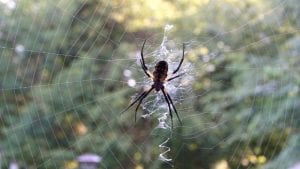
It lives in dark places. It is creepy. It causes some people to scream and run away. It has bulging eyes and eight legs. It’s a spider!
Spiders have long been associated with all the scary images of Halloween, including white filmy webs that can trap insects and even people who wander through them. How spiders came to be associated with Halloween is based in medieval folklore when festivals noted the change of seasons from summer to autumn and winter. The colors of orange and black also represent this change with orange reflecting the color change in the leaves and black forecasting the increased darkness with winter’s arrival and foliage death of the harvested plants.
Folklore also suggested that the power of witches was at its height during this time of year. Black bats and rats, as well as spiders, were considered companions of witches since they were all generally found in caves, dungeons and other dark, scary places. Spiders were especially associated with witches because of their magical powers to spin webs that could trap victims. It didn’t help the arachnid’s reputation when movies including Tarantula (1955), Kingdom of the Spiders (1977) starring William Shatner, and Walt Disney Studios Arachnophobia (1990) cemented spiders in the world of the creepy and dangerous. Despite EB White’s attempt to demystify spiders in his award-winning children’s book Charlotte’s Web, spiders continue to instill fear in some people.
But spiders don’t deserve a bad reputation since they are as varied in their habits and characteristics as other living groups. Spiders are not insects but belong to a class known as arachnids that also includes scorpions, mites, ticks and others. Features common to most spiders include two body parts connected at a thin waist, eight legs, fangs, two to eight eyes, and no wings or antennae. All spiders are predators but they don’t eat other living animals, and some eat plants. In the US, only three groups of spiders are poisonous and only two are found in Connecticut. The northern black widow, a native, and the brown recluse, a non-native that arrives in produce and containers from other regions, both avoid interaction with people and will bite only if threatened. If bitten, victims should seek immediate medical help.
As temperatures drop and seasons change many spiders, but not all, will seek out new places to call home. Often this is inside houses where warm temperatures provide sources of water, shelter and food, such as other insects and pests. Spiders are found everywhere except in the ocean and on Antarctica.